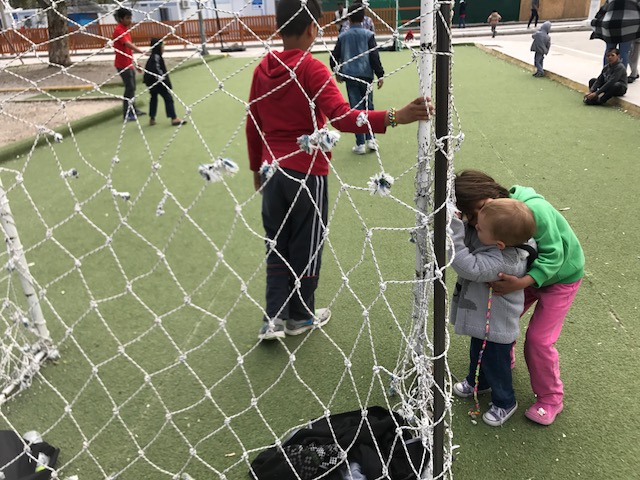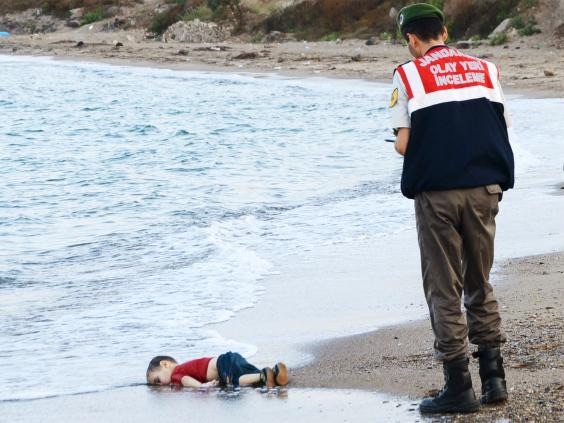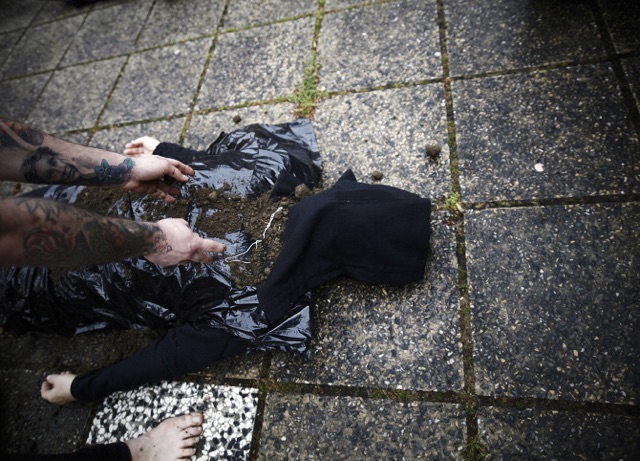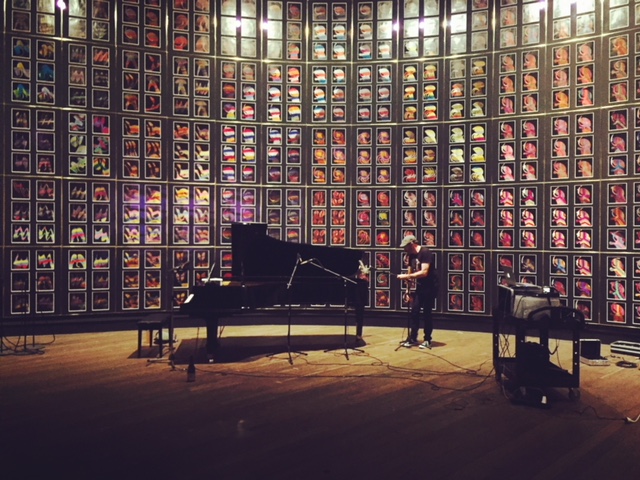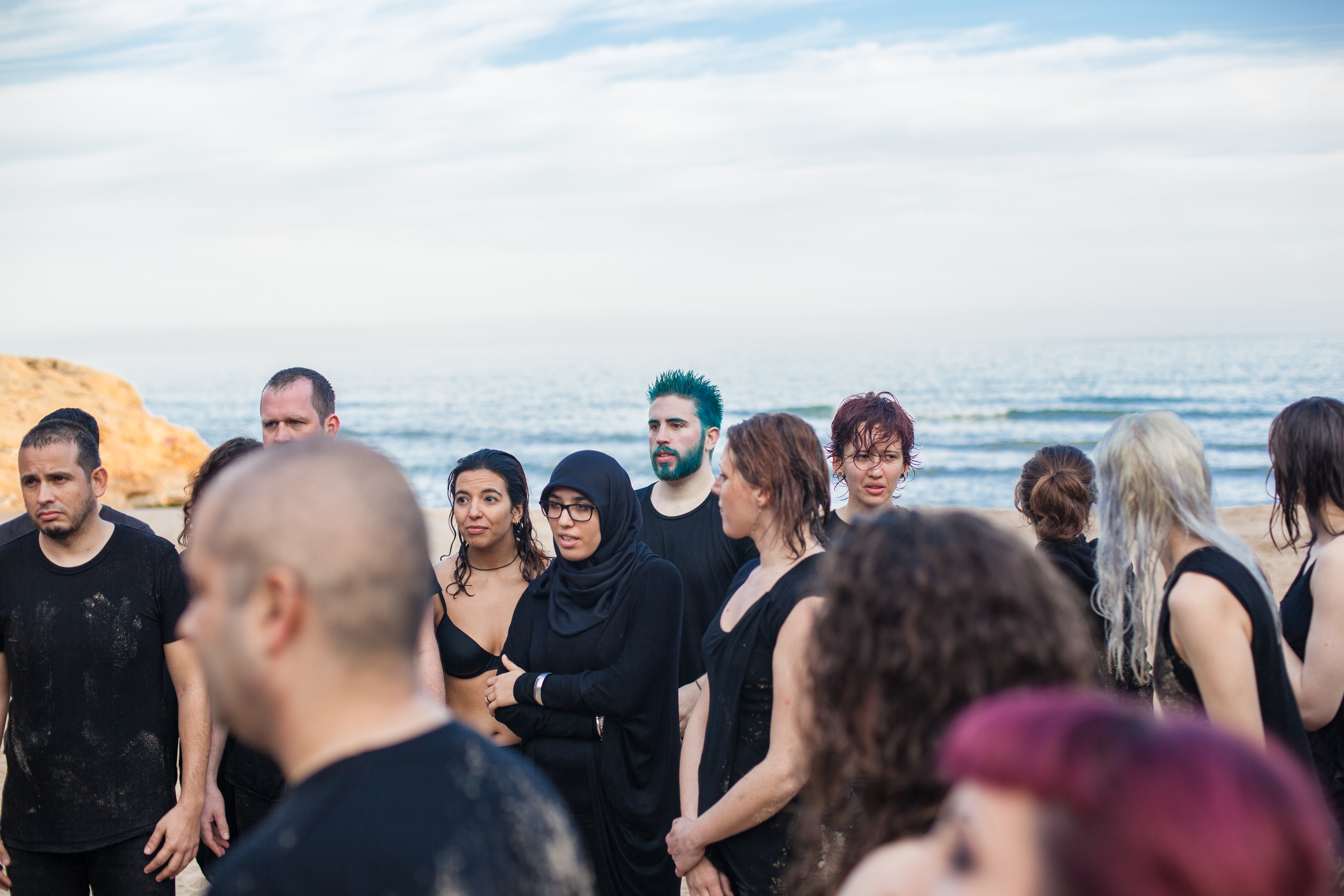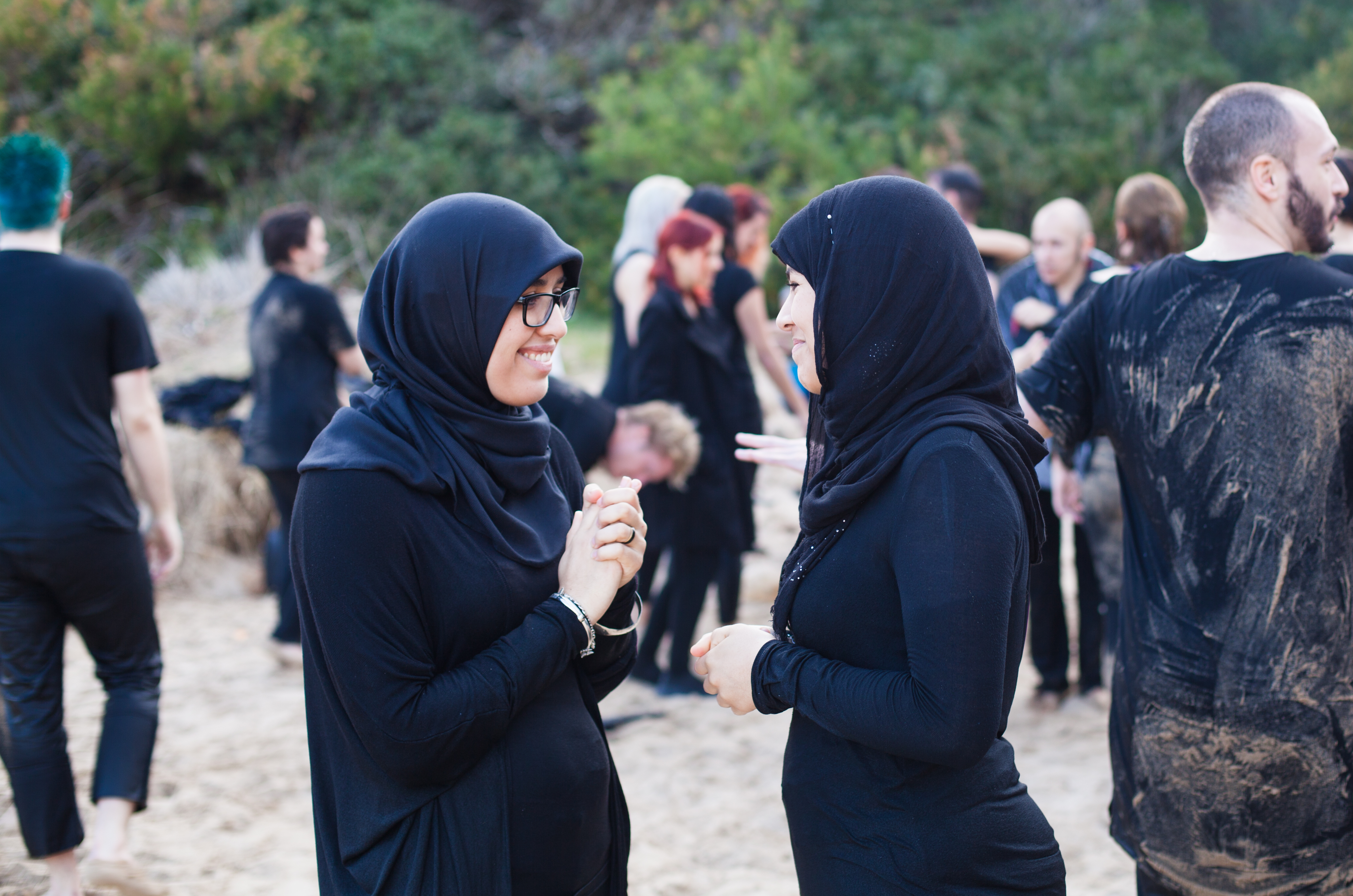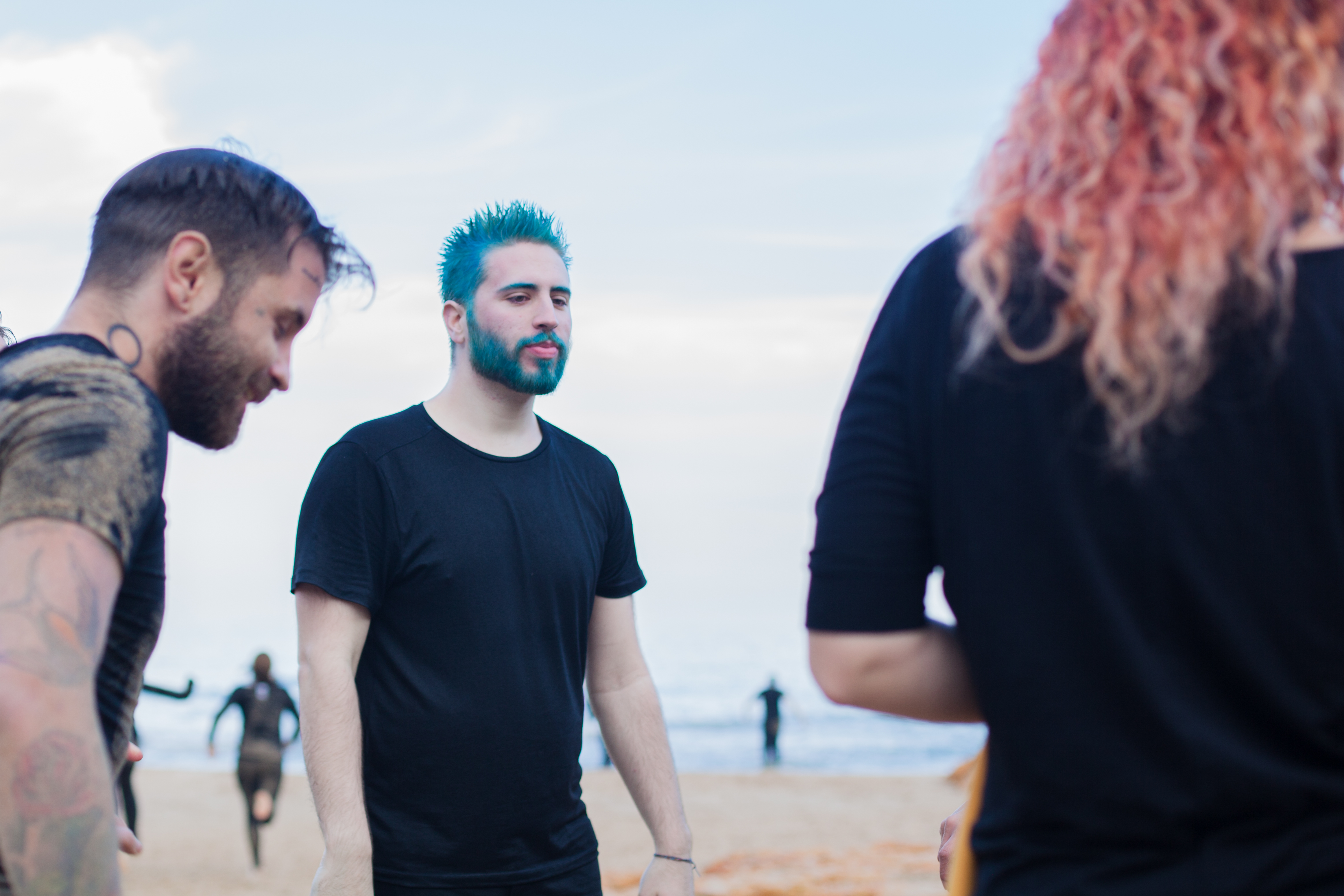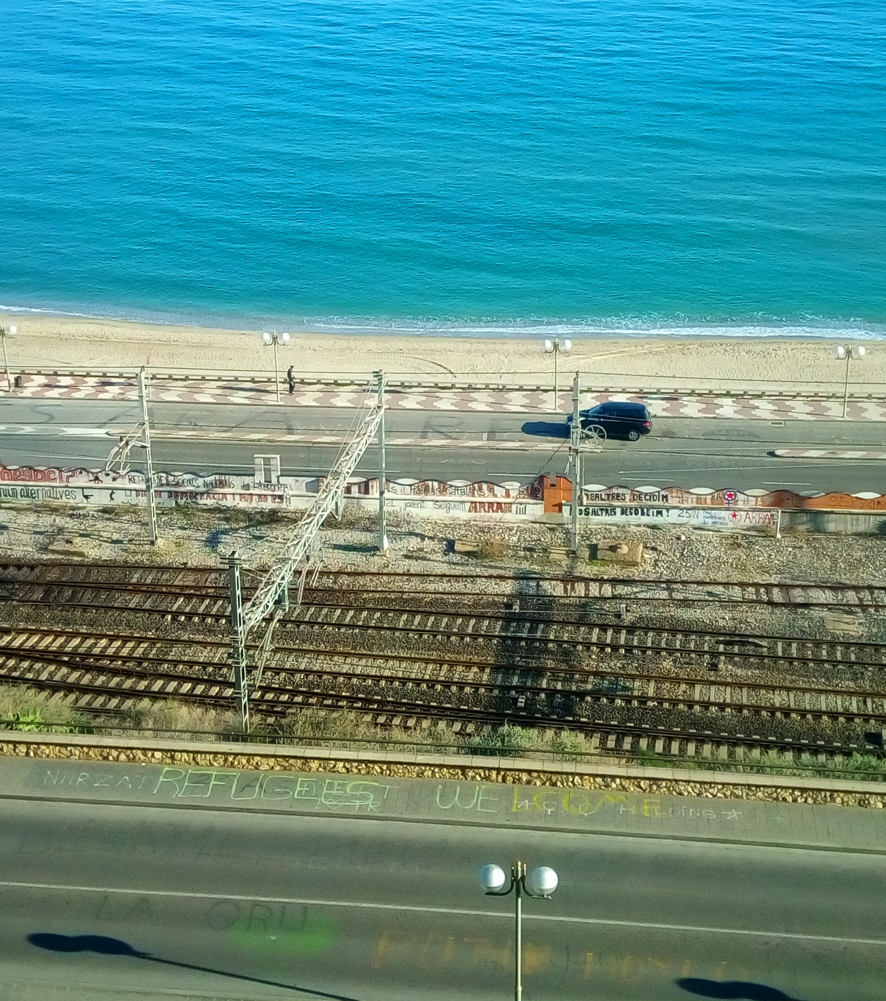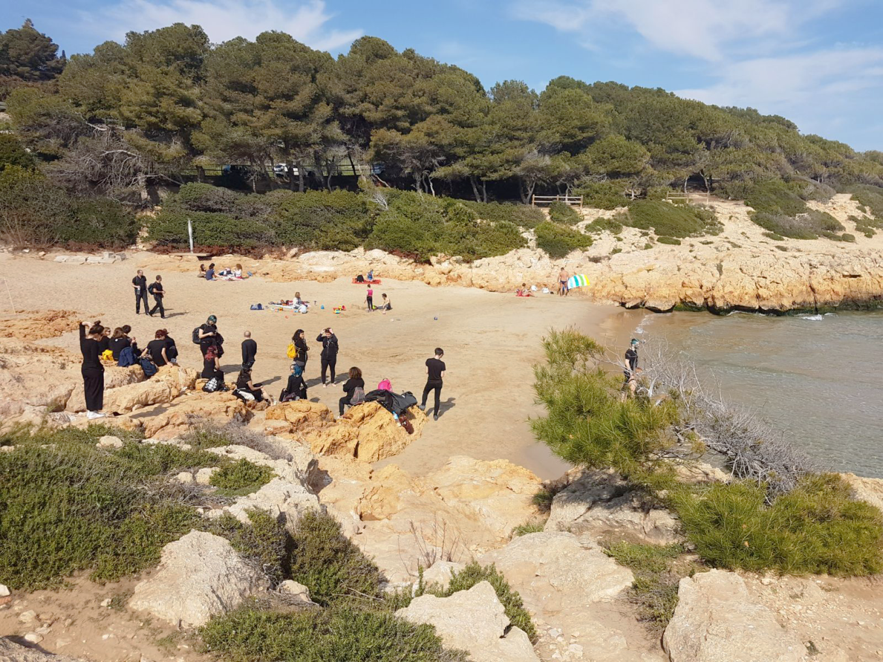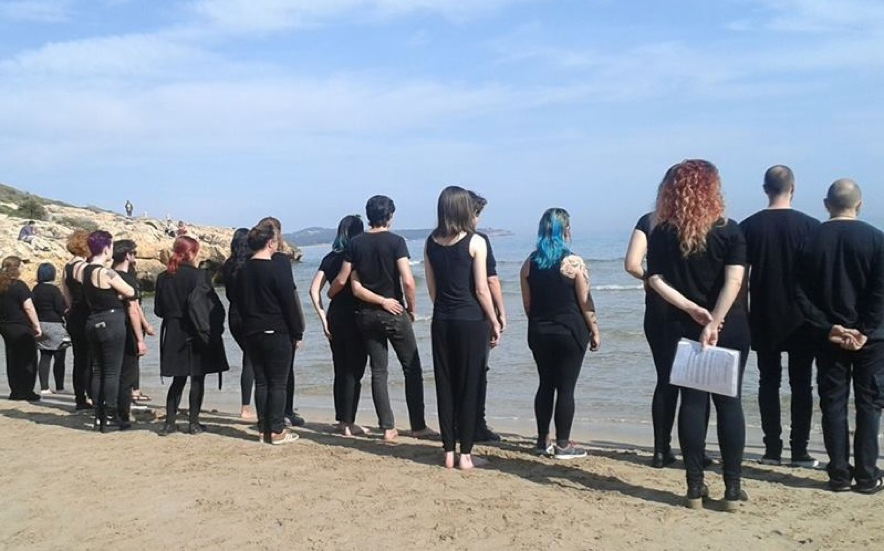Amanda Palmer – In Harm's Way
patreon only presale until official release on Nov 15th. patrons can find their order link + password here!
A side: “In Harm’s Way”
B Side: (wait and see)
100% of digital proceeds from this song and 10% of profits from this 7”, until nov 30th, will go to http://www.becausewecarry.org/en/ (more on that below)
![]()
as you can see above – i’ve got one physical musical offering for you this season, and it’s a 7-inch record. the A-side is “In Harm’s Way”…. the B-side is a surprise I will drop in a few weeks. both songs were made with jherek bischoff and his magical string quartet. both are really important to me.
the story of this song and video is long and intertwining. read at your own risk.
this past winter and spring of 2017, i traveled a lot. i traveled to australia and did a ton of writing and shows, and i wanted to do something on the way home from australia that felt, i dunno, useful somehow. i’d been in touch with the UNHCR for a while about doing a trip with them to a refugee camp (the way neil did a few years back), and i was chatting with them constantly throughout my trip to australia about where i could go. lebanon, pakistan, there were all these ideas. i was going to be traveling with ash. they came back and suggested that a trip to uganda, africa, would be the most helpful. i checked with the pediatricians. they suggested i go back and try to head for lebanon because of shots, new babies, and uganda not being safe. by the time i’d gone back and forth with the UNHCR three times about where to head, they gave up on me and told me the time wasn’t right, and i was crushed and felt guilty. i’d set a week aside in-between tours in australia and europe to go somewhere and do something. i did what i do: i went to social media. i asked my patreon. enough people told me they had connections in lesvos, greece, that i said: fuck it. that’s where i’ll go, and i’ll figure it out when i get there. when i saw that cookie arnone, one of my most beloved fans from london, was working at an NGO there, i knew it was fate. so that was it. i booked a ticket to lesvos and started reaching out to the NGOs that my friends and patrons had suggested. i went at the end of march, and had a seven-day experience that i will never, ever forget – and for so many reasons.
quick facts: lesvos is a tiny fishing and tourist island on the coast of greece. the normal population is less than 90,000.
between january and november of 2015 380,000 refugees washed up on the shore. ALMOST FOUR HUNDRED THOUSAND. picture this in your head.
i’ve been meaning to write a long-form article or blog about that trip since getting back – but it’s never been the right time. maybe releasing this song will rip the lid off and i’ll get it up in the next few weeks. but for now, let me post just a couple of the pictures i took there:
this is a mountain of life-jackets.
they all had to go somewhere…so this dump on lesvos is dedicated to the LITERAL TONS of life-jackets and boats that wash/washed up on shore carrying refugees.
this is ash playing with the kids at the kara tepe refugee camp. they were so insanely generous with him. i’ll write more when i write…but….look.
(also: there are strict rules about these refugee kids’ faces not being shown in public photos. this one felt pretty safe to post, to protect the kids’ identities.)
the trip changed me.
i took this outside the camp.
all of it encompassed the extreme pain and suffering and the extreme generosity and love of the place was explosive in all directions.
![]()
and now, the song.
rewind a year or so…to septemer 3rd, 2015.
remember this?
if you weren’t living out of the news cycle, you saw this.
this is aylan kurdi, a 3-year-old boy who was lying dead, face down on the shores of turkey during the crisis of 2015…and just happened to be captured by a news photographer.
but children were dying daily, hourly, minutely.
the world turned its attention to the crisis because of the photo, but the news cycle fades, and crisis didn’t go away. it persists.
when i saw the photo, like most people (i assume), my heart skipped a beat and i found myself crying.
how could all of us in this world be taking such poor care of one another?
what the fuck is happening?
i was due to give birth in two weeks.
my womb hurt.
![]()
two weeks later, i gave birth to ash in the woods of tenessee, far away from the news, far away from everything. my kamikaze-cabaret friend meow meow called and told me she was working on an original meow-style production of hans christen anderson’s “the little mermaid” for the malthouse in melbourne, and would i contribute a song?
i wanted to. but couldn’t. i barely had time to pee or answer my texts or make a bowl of soup. i’d just given birth. i told her i wanted to, but i just… couldn’t find the mental or physical time.
a few months later, in december, after we’d gotten back from our birth-journey and visiting some relatives, i was home with ash in boston and neil was off…somewhere.
meow called me at 5pm. the show was going into production in a week, she said, but she was still short one song. she needed a song where the little mermaid was standing on one shore, looking at the other, and trying to make sense of love and loss.
DON’T DO THIS TO ME, MEOW. we talked for an hour about love. and loss. and water. and pain. and healing. and all the things. while i cradled and nursed a baby.
i told her there was almost no chance in hell i’d be able to write anything. babies and empty apartments and pianos just don’t match. (this was all before i discovered the wonders of babysitters).
and then – as fate would have it – ash decided to take a spontaneous baby nap.
i sat down at the piano in my boston apartment and wrote the first draft of “in harm’s way”….which, at the time, i titled “the refugee’s brother.”
i sent it to meow in the morning. i said it was the best i could do during a baby nap. but i was proud of it: it captured something.
meow took it off to its own arrangement-world, tweaked the lyrics a little, and created something beautiful out of it (you’ll be able to hear when she releases the official CD for her show), and i stuck the song in a box.
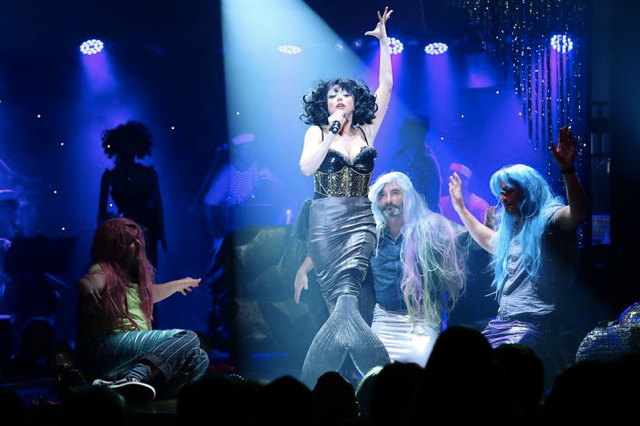
ash was three months old.
![]()
around the same time, i discovered the spanish performance artist abel azcona on twitter. i don’t remember who retweeted something by him that wound up in my feed, but his work looked intriguing so i went to find out more. i read about the controversy he was facing for stealth-collecting sacramental wafers for months and months during catholic ceremonies and then taking the host wafers to spell out “PEDERAST” in large letters outside the church.
this was one brave motherfucker. i looked at some of his film work. i saw the photos he was putting out from his piece using a belly. i was sold.
he did this public project called “buried”:
obviously, this was my people.
i wanted to make something with him.
we DMed each other. what could we do?
an idea formed…i couldn’t imagine making a “normal” music video for a song like this. maybe he could create a performance to complement the intensity. we talked. we came up with a plan. we put a call out for volunteer performers to come to a beach in spain.
ash was six months old.
![]()
abel needed a finished version of the song in order to shoot.
i was in tasmania, at the MONA museum, when i sat down in a small shed with a keyboard to write a second draft of the song.
(if you’re one of my $5+ patrons, i’m sending you the original demo of the song i sent to meow, you’ll recognize some sections, but you’ll see that i changed a lot of it).
i went back to the picture of aylan.
i thought.
and then i saw the video footage of aylan’s father.
i can’t find a link at the moment – but there was something viscerally upheving about watching this man openly weeping and pounding his fists on the wall.
everything caved in.
the cameras trained on this man.
humanity, standing by.
doing…what?
the mona museum graciously let me squat in their museum (where i had a concert, and therefore, a grand piano) and record this song at midnight.
they even donated a couple bottles of wine from their front-yard vineyard.
here we were…setting up in the nolan gallery. that painting is a massive work (it’s a painting made up of 1620 paintings) by the renowned australian artist Sidney Nolan.
you can read about it here.
this was the day after.
ash was one and a half years old.
![]()
i sent the recording to jherek bischoff, because it WANTED strings.
he listened, he heard, he got to work. he was in dusseldorf, working on this play – based on ETA hoffman’s “The Sandman” – with robert wilson (theater hero).
so….he stole some time, found some string players, and created the beautiful arrangement and strings that you hear.
he recorded them IN the house he was living in in dusseldorf.
he mixed it.
i sent it to abel.
abel and everybody met on the beach, and filmed. (words from abel, in spanish and in english, below).
then it took a long, long time to edit it together and wait for the right moment to put it out.
that’s now.
the refugee crisis is still mounting – if you read the news you can see: it’s happening everywhere. here in america, we should be hanging our heads in shame: trump’s proposed refugee laws would slash the number of refugees we take in by half. it’s insane. and while, right now, there are no pictures of aylan circulating on facebook, but every single day, hour, minute, aylans are being forced from their beds, their homes, their lives…aylans are dying, unphotographed, unseen, unheard.
humanizing all of this is the key. if you can’t see these children as your own….you’re not seeing.
100% of all the digital proceeds for this song (and 10% of all the sales from the 7”) are going to go to becausewecarry.org, who i know will be very very happy for the help. i just got off the phone with steffi de pous, the brave soul who started this bootstrap organization because she was in lesvos, volunteering, and saw the needs of mothers who had no baby carriers. she went back to holland and gathered up every baby carrier she could. and she flew back to lezvos and handed them out. and then did it again. and again. now she runs a full-time operation that provides food and all sorts of activities for the families who are stuck there. she’s my hero. she just told me that the situation is getting dire again: over a hundred refugees a day are arriving by boat on the island, and 60% of them are children. winter is coming. there isn’t a proper plan, island-wide, to keep these people warm. they need all the help they can get.
also: if you are wondering what you can do and want to do something dramatic (especially if you’re in the UK or europe), you can put together a group of volunteers and head over there. you need to pay your own expenses and buy in, but a week helping the refugees at kara tepe will change your head. grab a group of friends. GO. literally…GO. the link to volunteer is here, tell steffi i sent you: http://www.becausewecarry.org/en/about/
after abel and everybody met on the beach, and filmed. included in the volunteers from all across the UK and Europe were two very special people: alex knight (who many of you know as the coordinator of our UK merch store and long time Team AFP member and moderator of the Facebook community), and felix marquez, an artist and spanish fan of mine who’ve loved and connected with on social media for years. i was so happy to be able to see all of these people in the same place at the same time…making something. some words & pictures from all three of them – abel, alex and felix – are in spanish and in english, are below.
thank you for listening, thank you for watching, thank you to all the artists who contributed their time and love to this project and thank you to my patrons, who footed the bill for the whole thing.
we are all here together.
ash is two.
![]()
-THE LYRICS-
what i cannot see cannot be not untrue
standing on the barrier of me and you are
standing where the ocean meets the sand
we cross though we barely understand
the grass is always greener on the land
what we cannot say cannot be not our fault
searching for a harbor where the sharks don’t call
i’m waiting where the boats arrive at night
i see the ones before me disappearing into light
why would you go? when you could stay?
why would you try? when you could walk away?
why should i care when you’re not mine?
why would i care when you’re not even my kind?
why would you stand when you could lie?
why would you bother to find something kind to say?
why would you bother to love your own neighbor?
and why would you bother to love your own brother?
….love’s so expensive these days.
what i cannot do cannot be not undone
blinking at the reef collapsing in the sunrise
shining from this pamphlet in my hand
we cross as many fingers as we can
the grass keeps looking grayer as we find no place to land
what i cannot see can not be not unseen
standing on the barrier
of you and me
are standing where the ocean meets the land
we cross even though we understand
we cross even though we see the child in the sand
why would you go?
when you could stay?
why would you try?
when you could cast away?
why should i care
when you’re not mine?
why would i care
when you’re not even my kind?
why would you stand
when you could lie?
why would you bother to find something kind to say?
why would you bother to save your own neighbor?
and why would you bother to save your own brother?
why would you bother to save your own child
why would you bother with all of this bother
and why would you bother with all of these others
when there’s always you you could save….
why, what are you crazy?
why would you stand in harm’s way?
![]()
-A WORD FROM ABEL-
More than 25 million people have been forced to leave their homes. Most of them cannot return to their home country due to an entirely real fear of being persecuted due to their race, religion, nationality, political beliefs, or for belonging to a certain social group.
Since 2015, the project “El Milagro” (“The Miracle”), created by the artist Abel Azcona, has been performed in 24 cities and beaches around the Mediterranean. From Marseille to Lesvos, Nice to Palermo. It is both a performance and an installation, where the artist seeks a personal reflection of social criticism. More than two thousand people have taken part in the performances, where they walked for hours in their home towns, before symbolically ending up in the water, completely submerging themselves.
During the performance, every one of the participants goes on a personal journey, trying to empathise with the horror that has been responsible for so many victims’ lives in the last decade. Thousands of men, women and children have died in the oceans without any recognition or responsibility from a desensitised and cruel society. With this artistic work, the participants put themselves into this process for several hours, ending up on a beach where they form an installation of hundreds of bodies, without for one second forgetting all of the real-life victims. This act was created as a tool of empowerment, criticism, and a united fight.
In this last performance in 2017, almost a hundred people walked through the city of Tarragona, the city where the installation was first carried out in 2015. Altogether there were more than fifteen nationalities: American, Finnish, Swedish, Australian, French, Mexican, English, Spanish, Filipino, Italian, Moroccan, Syrian, Dutch, Colombian, and Argentinian walkers all condemned the situation, with their own bodies floating in the Mediterranean ocean as a symbol of unity and empowerment. This last performance was designed and created between the artist Amanda Palmer and the artist Abel Azcona, together with all of the participants.
—
Más de 25 millones de personas han abandonado su hogar a la fuerza. La mayoría no pueden regresar a su país de origen por un temor bien fundado a la persecución por motivos de raza, religión, nacionalidad, pertenencia a un grupo social determinado u opinión política.
Desde el 2015 el proyecto «El Milagro» creado por el artista Abel Azcona ha sido realizado en 24 ciudades y playas del mar Mediterráneo. Desde Marsella hasta Lesbos, pasando por Niza o Palermo. Un proyecto performativo e instalativo donde el artista busca una reflexión en primera persona impregnada de crítica social. Más de dos mil personas han participado activamente en las acciones, todas ellas caminando durante horas en sus ciudades de origen, para terminar de forma simbólica en el interior del agua hasta ser cubiertos por la misma.
Cada uno de los participantes ha realizado en la performance un viaje interno con el fin de empatizar con uno de los horrores que más víctimas mortales ha causado en la última década. Miles de cuerpos de mujeres, hombres y niños han perecido en los mares sin ningún reconocimiento ni sentimiento de culpa por una sociedad anestesiada y cruel. Con esta obra artística, los participantes realizan un proceso en primera persona de varias horas de duración, hasta terminar en la playa formando una instalación de cientos de cuerpos, sin perder en ningún momento a todas las víctimas reales de su memoria. Esta acción nace como una herramienta de empoderamiento, crítica y lucha común.
En esta última performance en 2017, casi cien personas recorrieron la ciudad de Tarragona, ciudad que fue la primera en realizar la acción en el año 2015. Todos ellos, de más de quince nacionalidades diferentes. Caminantes estadounidenses, finlandeses, suecos, australianos, franceses, mexicanos, ingleses, españoles, filipinos, italianos, marroquíes, sirios, holandeses, colombianos y argentinos denunciaron con sus propios cuerpos flotantes en el agua del mediterráneo, como símbolo de unión y empoderamiento. Esta última performance diseñada y creada en común por la artista Amanda Palmer y el artista Abel Azcona junto a todos los participantes.
![]()
-A WORD FROM ALEX-
-A WORD FROM FELIX-
All pictures taken by either Alex or myself, unless otherwise noted.
Tangerine trees, loaded with fruit, line the streets of Tarragona, and I already love this place.
After leaving my backpack in the hostel, I walk along the main street all the way to the lookout over the beach. On the street below, among some lowercase leftie graffiti, “REFUGEES WELCOME” is painted on the sidewalk.
“Refugees welcome.”
I meet Alex (a friend of mine and Amanda’s assistant) and we explore a little. It’s a typical Mediterranean town: there’s palm trees, a beautiful cathedral, lots of squares with cafés and narrow streets full of bars, and a bunch of Roman ruins from several millennia ago.
Alex and I try to figure out how to reach the beach where the performance will begin, called Cala Romana (Roman Cove). According to Google Maps, there is no such beach, but there is a neighborhood by that name near three beaches, one of which is very small. We tweet at Abel asking for confirmation, and decide we’ll just walk over there.
The next morning, we walk for half an hour along some inconvenient roads, only to find out, near the end, that we could have just used some beachside trails Google Maps knew nothing about.
“How the fuck do we get over there?”
Down at the beach, there’s some children, a family having a picnic, and a very enthusiastic dog. To the right, waiting perched on some rocks, we spot a dozen young people, dressed in black. I see I’m not the only one with blue hair.
Speaking to them, I’m surprised to learn about how varied their backgrounds are. There’s a boy from Bilbao, a girl from Czechoslovakia, two students from Chicago, and a girl from Arizona who now lives here with her Catalan boyfriend…
Over the next half-hour, more people trickle into the beach. Eventually, Abel shows up with a few camerapeople and a couple of assistants.
Here’s what I know about Abel Azcona: he grew up in my city, Pamplona, and graduated from high school through the Arts modality at the School of Arts and Crafts of Pamplona, as I did. Then he went on to become a highly successful, provocative performance artist, whose extreme pieces have been repeatedly challenged by authority figures. Inspired by his childhood experiences, he created The Shadow, where thirty other survivors of child sexual abuse joined him in telling their stories.
Over the next half-hour, more people trickle into the beach. Eventually, Abel shows up with a few camerapeople and a couple of assistants.
Here’s what I know about Abel Azcona: he grew up in my city, Pamplona, and graduated from high school through the Arts modality at the School of Arts and Crafts of Pamplona, as I did. Then he went on to become a highly successful, provocative performance artist, whose extreme pieces have been repeatedly challenged by authority figures. Inspired by his childhood experiences, he created The Shadow, where thirty other survivors of child sexual abuse joined him in telling their stories.
The resulting avalanche of disclosures from members of the audience, and the fact that many of those cases involved members of the Catholic Church and Opus Dei families, led him to create another piece: he attended church services, hid the consecrated, uneaten wafers, and then spelled “PEDOPHILIA” with them in a museum. The reaction was swift: Pamplona’s right-wing establishment organized demonstrations in front of the museum, with mass prayers and some self-flagellation. Abel merely tweeted a picture praising the protestors for developing the performance further than he could have dreamed.
In short, what I know about Abel Azcona is that he’s here to stir things up and the amount of fucks he gives is nearly imperceptible.
His team is helping the other volunteers find the beach—we might be close to a hundred. Once everyone has arrived, we get in a circle and he explains what the process will be. Once he’s finished, I translate for non-Spanish speakers.
We’re going to go on a walk together around Tarragona. A few camerapeople will accompany and film us, along with a camera drone. We will be picked up by two Syrian girls and led to this beach, where we will wade into the water and the camerapeople will continue to film us with underwater cameras and diving suits. The performance will begin in Tarragona and end here, but he wanted us to meet at the beach because there is more to the process than just the trip: the physical journey is a trigger for an inner one.
(There are two sides to this project, which I find interesting: on one hand, our performance needs to work on its own, inside us, and that’s a goal in itself. On the other, our internal process exists so it can be captured by the cameras and used as an ingredient on a video, which, being visual art, must kick start its emotional magic through pure surface.)
So we all walk closer to where the water licks the sand, and we stare at the ocean. Abel asks us to think of a destination, but keeps it vague. It might be a goal we wish to achieve, it might be an inevitable outcome or a necessary point to reach, or it might simply be an unknown future we are still willing to walk up to. In any case, it’s something to be drawn to.
Picture by Sara Requena.
Later, while writing this text, I will ask some of my new friends what their thoughts were.
“I thought about how all the water on Earth is the same,” said Sara, a photographer. “It reaches every shore in the world in the same manner.”
“It’s both unity and separation,” adds Alex. “This whole, huge expanse of water keeps parts of the world totally separate from each other and prevents us from just walking across.”
Staring at the water, for a while I struggle to come up with a personal meaning. So many things have gone south over the last years of my life that the list of things I’d like to change is endless. I start to feel stressed about my own excessive self-consciousness. Seeing the waves shift, I remember how explanations of Buddhist dharma will often use waves and ripples as a metaphor for our fearful minds, as we let negative thoughts repeat and amplify each other. I picture myself diving in, how peaceful it will be when my chronically sore body feels weightless. I think of the inside of a womb (Amanda apparently liked that particular beach because it was appropriately shaped somewhat like female genitalia). I remember Solaris, the 1961 science-fiction novel by Stanisław Lem, where human scientists encounter a planet solely inhabited by a giant, sentient ocean.
I decide that the one thing I want, what the ocean represents to me, is some peace of mind—harmony between thought, feeling and desire, with no fear. (And the sunlight is scorching, so the prospect of a bath sounds amazing in any case.)
Part of me feels strange about using the plight of Syrian refugees as a springboard for exploring my own problems as a white European dude, but I realize that what I make of it is up to me—and, in the end, this is an exercise in empathy. That gap is for me to cross by thinking and listening.
Once we’re finished meditating on the meaning of the sea, we get in groups, then the groups get in cars and we drive to Tarragona. We leave our shoes and backpacks in the cars and we meet at the square in front of the cathedral.
Abel asks us to lie down on the stone floor. He walks among us and says sentences. They don’t add up to one specific story; rather, they offer options, windows into hypothetical lives:
“There was a time I was afraid.”
“There was a time I felt I had no home.”
“There was a time I felt desired.”
“There was a time I had to travel very far.”
“There was a time I didn’t feel afraid.”
“There was a time …”
When he’s done, he encourages us to think of examples of our own, personal ones. Some people say their sentence (“There was a time I could finally cry,” “There was a time I knew it was the last time I’d see him”…) and then they stand up. I try to think of a sentence for me—I think of stories, and angles in stories, and which I prefer, and why. I don’t get to say my sentence: after six or seven interventions, Abel decides we’ve all thought through it and asks us to stand.
“That action, with our eyes closed, allowed us all to be vulnerable, but also be strong in expressing that vulnerability,” says Sara.
By the cathedral, we’re introduced to the two Syrian girls, and start walking around the town behind them. Abel’s assistant leads us, while Abel himself disappears among the crowd. We begin to walk.
I wonder if the tangerine trees smell as good as orange blossoms do before the flowers turn to fruit. Speaking of which, Abel has just stepped on a ripe tangerine and he’s trying to wipe his foot on the ground. He silently points at it before resuming his walk, and so we all sidestep the orange roadkill and point at it too as we walk on, so those behind us know there is something to avoid.
After this tiny act of cooperation, this functional kindness, we continue navigating the city. A bunch of men emerge from a local parish, carrying a float with a statue of Virgin Mary surrounded by enormous candelabra, and I can’t help but wonder if Abel somehow timed our walk so we’d meet them. I assume the camerapeople aren’t photographing them. The parishioners are practicing for the local festivities. A bunch of teens and children rehearsing their drumming for the street band that accompanies those floats.
Through the project’s careful emotional framing, everything slowly becomes enhanced, magical, with echoes of meaning, like you’ll find the world aligned into a constellation if you just find the right vantage point. Everywhere you look, you might catch a glint from a thread in the fabric of space-time: we walk, barefoot, through a street named Calle de los Descalzos (Street of the Barefoot), named after the Order of the Discalced Carmelites. A sign on the opposite building states it was built in 1992, the year I was born.
Some people on the street turn their heads and stare at us. Others don’t seem to care. I catch bits of everyday conversation:
“… Yes, she’s applying for the job! The interview’s on Thursday …”
“… no, it’s two bags. I told you. They’re in two black plastic bags …”
See, everything feeds into the performance. Here we are, surrounded by local religious iconography, feeling the stone slabs under our feet, avoiding the tangerines, tripping on the normality of a peaceful Mediterranean town. This is my country, but it’s not my province, and my brain is jammed with all the tiny differences and similarities to the place where I grew up. It does feel like home.
The mundane seems illuminated, while the sacred seems to have been stripped of transcendence: Virgin Mary’s float is wrapped in plastic, so as to not damage the statue, and the candelabra are empty, and the carriers were in everyday wear—it’s just a rehearsal, after all. Watching them, I understand they’re preparing an artistic performance too, albeit a traditional one rather than an exploratory one.
I think of how Christians worship Mary as a mater dolorosa (grieving mother) and of Alan Kurdi, the dead child refugee washed up in the sand. While local customs change in every area of the world, the nature of human life is the same. There will always be thought, worship, work, food, death, love, certainty and uncertainty.
In my heightened state, everything seemed so closely woven into the fabric of life. I think of Indra’s net, a Buddhist visualization of the world as an endless net, with jewels at every nexus reflecting every other jewel: every moment in time holds within it the necessity of all previous moments and the inevitability of all future ones.
You can reach and understand all of existence from absolutely any starting point, if you see it with curiosity instead of using your mind’s shorthand—prejudice, assumption, solidified views. All of thought and all of feeling are always within hand’s reach. Even though we might need art to shake us up to it.
Again, the element of artifice: the Syrian girls lead us up to a rock, where they sit and watch as we walk by and disappear down a slope. I expect that this shot will be used in the video to make it seem as though the city leads down to the beach, and the girls (who, on the previous morning, have shot some footage of them reaching land on a boat) have led us back to their landing site, helping us find what we were also looking for.
Down the slope, near the parked cars, we have a group hug. Some people start crying. There’s something about human contact that almost startles me in its intensity: I haven’t really been touched by anyone in a while, for one, but also the previous exercises have given us all a sense of connection, and it feels so peaceful and right for all these strangers and new acquaintances to be entirely open to warm contact.
Part of the reason the entire experience felt heightened, like an aperture of sorts, is that we were exploring an unknown territory and our physical motion seemed to propel, and be propelled by, our mind trip. Being barefoot helped ground us in material reality. Indeed, when I ask Sara later what her memory of the walk is, she immediately goes back to the physical feeling: “I remember the textures under the skin of our feet. I remember the trance-like state. The tiny rustles and thuds people made with their steps, the clothes grazing… I remember calm.” Alex remembers “how uncomfortable the rock floor was—and what a wonderful luxury it is to have shoes we can wear, normally. A girl cut her foot, but continued to walk leaving bloody footprints on the street. I hope she recovered.”
Back at the beach, Abel tells us we can enter the water at our own pace. Most of us walk in quite decidedly, although the cold slows us down.
Janel, a writer from Arizona, told me about what she had felt while initially staring at the ocean: “I have a deep and lifelong love for the ocean. I started scuba diving when I was eleven years old. It’s the closest thing to flying through an alien world that I know of. So this is what I think when I look out at the sea: the water contains worlds I don’t belong to. When I get to enter the ocean, it is a gift and a privilege.”
Some people swim close to the shore, some of us get far away from it and dive. I try to move as much as possible, and soon the cold is gone and the water feels welcoming. I sink repeatedly to the bottom, keeping my face close to the sand as I move, imagining I’m an octopus on the hunt, trying to find something interesting in the few inches of space I can clearly see before me. I grab handfuls of sand in my hand and watch it inevitably filter out into amber clouds. Something about diving always feels like a dream state. I let myself float up, weightless and refreshed, and sink again. After a while, I stay afloat, looking around me to observe other people’s body language. Some are floating on their backs.
I was one of the first to go in, and I’m one of the last to come out. The camera people track us as we walk out. I’m sad I have to leave. Man, I love water.
I walk out (still from the video).
Once we’re all out, we dry our hair and change clothes behind the rocks, then stand in a circle and Abel asks for our impressions. Most of us are somewhat shocked by our realization of just how hostile the sea is if you’re not prepared to be in it—how deadly it can be to cross.
Anastacia, a circus student from Chicago, explains that when she dived in, she was “so cold I was paralyzed… I remember giving into the cold… but realizing that staying still was only going to make the cold worse, I started to swim. Maybe there’s a metaphor somewhere in that.”
“The coldness made the whole experience extra sensory”, says Alex. ׅ“I guess it was pretty sobering to realise that we could just go in the ocean at our leisure and leave when we got too cold or uncomfortable, whereas for others it is a huge obstacle that they have no choice but to confront.”
Anastacia also remembers “thinking about my mom and my grandma and my great aunt. They all emigrated to the United States from Russia… my mom was only twelve years old. It was very traumatic for my grandma. I remember thinking about their journey… How scary and hopeful and hard and exciting it must have been. I mean, I can’t even imagine being 12 years old and having to leave the only place you have ever known. Or being my grandma or her sister and making this courageous decision for the hope of a better life.”
Asked about her experience days later, Sara says “it was a beautiful sensation, how everybody walked their particular path within this collective experience. Taking part in this performance and video with people from such diverse backgrounds but similar sensibilities has helped me reconnect with my own emotions.”
I can add very little to that, except for this final anecdote: that night, back at the hostel, I was too exhausted to shower, and I woke up the next morning to discover my salty hair had left a blue stain on the pillow. I turned the pillow over, hoping nobody had noticed, before leaving for the bus back to my rainy home.
—-
Las calles de Tarragona están decoradas con mandarinos cargados de fruta: esta ciudad ya me encanta.
Tras dejar mi mochila en el hostal, recorro la calle mayor hasta el mirador que se alza al final, sobre la playa. Abajo, en la calle, entre grafitis con mensajes de izquierdas en minúsculas, alguien ha pintado «REFUGEES WELCOME» en la acera.
“Refugees welcome.”
Me reúno con Alex (un amigo mío y asistente de Amanda) y exploramos un ratito. Es la típica ciudad mediterránea: hay palmeras, una hermosa catedral, muchas plazas con cafeterías y callejuelas llenas de bares… y las milenarias ruinas de un anfiteatro romano.
Alex y yo intentamos averiguar cómo llegar a la Cala Romana, donde se realizará la performance. Según Google Maps, esa cala no existe, pero hay tres playas, una de las cuales es muy pequeña, cerca de un barrio del mismo nombre. Enviamos un tuit a Abel pidiendo que nos lo confirme, y decidimos que iremos andando.
La mañana siguiente, caminamos durante una media hora por unas carreteras bastante frustrantes sólo para descubrir, hacia el final, que podríamos haber usado unos caminos paralelos a la playa que Google Maps no conoce.
«¿Cómo hostias se va a ese lado?»
En la cala hay unos cuantos niños, una familia de picnic, y un perro muy entusiasta. A la derecha, posados en unas rocas, hay una docena de jóvenes vestidos de negro. Veo que no soy el único con el pelo azul.
Al hablar con ellos, me sorprende lo variada que es su procedencia. Hay un chico de Bilbao, una chica de Checoslovaquia y dos amigas de Chicago, todas estudiantes de intercambio, y una chica de Arizona que ahora vive aquí, con su novio catalán…
Durante la siguiente media hora, más gente va apareciendo por la playa. Eventualmente, Abel aparece con unos pocos cámaras y un par de asistentas.
De Abel Azcona sólo sé: que creció en mi ciudad, Pamplona, y terminó el bachillerato artístico en la Escuela de Artes y Oficios, como yo. Y entonces comenzó una exitosa carrera como provocador artista de performance, habiendo sido sus obras blanco de muchas críticas y condenas. Basándose en sus experiencias de infancia, creó The Shadow, un proyecto de denuncia con treinta otros supervivientes de abuso sexual infantil, en que todos contaban sus experiencias.
El torrente posterior de sinceramientos por parte de espectadores, y el hecho de que muchos de esos casos involucraran a miembros de la Iglesia católica y a familias del Opus Dei, lo llevó a crear otra obra: tras asistir a múltiples misas y guardar sin ingerir las hostias consagradas, escribió «PEDERASTIA» con ellas en el suelo de un museo. La reacción no se hizo esperar: el establishment de derechas de Pamplona organizó protestas frente al museo, con oraciones y alguna que otra autoflagelación. Abel respondió tuiteando una foto de la manifestación y agradeciendo a los participantes haber dado a su obra una acogida tan calurosa.
Es decir, de Abel Azcona sólo sé que su objetivo es provocar reacciones y que las críticas le importan aproximadamente cero pimientos.
Su equipo está ayudando a los demás voluntarios a encontrar la playa. Puede que seamos unos cien. Una vez todo el mundo llega, hacemos un corro y nos explica el proceso. Cuando termina, traduzco para los no-hispanoparlantes.
Vamos a recorrer Tarragona a pie, acompañados por cuantos cámaras y un dron que nos filmarán para el videoclip. Dos chicas sirias se reunirán con nosotros y nos guiarán de vuelta a la playa, donde nos sumergiremos en el agua. Seremos grabados en el agua también, con cámaras submarinas. La performance comenzará en Tarragona y terminará en esta playa, pero Abel quería reunirnos aquí porque el proceso no es sólo de desplazamiento: nuestro viaje físico es el apoyo de un viaje interno.
(Este proyecto tiene dos caras, lo cual me parece interesante: por una parte, nuestra performance es un acto que debe funcionar por sí mismo; es su propia meta. Por otro lado, nuestro proceso interno existe para ser captado por las cámaras y empleado como ingrediente de un vídeo; que, al ser arte visual, debe poder causar un impacto a través de su mera superficie.)
Así que nos acercamos a las olas que lamen la arena y contemplamos el océano. Abel nos pide que pensemos en una finalidad, pero no nos da ideas concretas. Quizá debamos pensar en un objetivo que deseemos cumplir, o un resultado inevitable que debemos atravesar, o quizá simplemente un futuro desconocido pero que aun así queremos alcanzar. En todo caso, será nuestro un punto de referencia.
Picture by Sara Requena.
Más tarde, redactando este texto, preguntaré a algunos de mis nuevos amigos cómo vivieron su experiencia.
«Pensé que toda el agua de la Tierra es la misma» me cuenta Sara, fotógrafa. «Que llega a todas las orillas del mundo del mismo modo.»
«Es unidad y separación», añade Alex. «Esta enorme expansión de agua mantiene partes del mundo completamente separadas unas de otras, e impide que simplemente caminemos entre ellas».
Al principio me cuesta encontrar ningún significado personal al agua que contemplo. Tantas cosas han salido mal durante los últimos años de mi vida que la lista de cosas que querría cambiar o conseguir es interminable. Me estresa un poco estar pensándolo tanto. Viendo las olas cambiar de forma, recuerdo que el dharma budista suele compararlas con la manera en que dejamos que los miedos e inseguridades se amplifiquen en nuestra cabeza. Imagino la paz que sentiré al sumergirme, sentir cómo el peso se desvanece y el dolor crónico desaparece de mi cuerpo. Pienso en el útero materno (al parecer, a Amanda le gustaba esta cala en particular porque le recordaba a los genitales femeninos). Recuerdo Solaris, una novela de ciencia-ficción de Stanisław Lem, de 1961, en la que un equipo de científicos humanos halla un planeta habitado por un océano consciente.
Decido que lo que realmente quiero, lo que el océano representa para mí, es cierta paz mental: una armonización de pensamiento, sentimiento y deseo, sin espacio para el miedo. (Y el sol quema, así que la idea de un baño suena genial en todo caso.)
Una parte de mí se siente incómoda por estar usando la tragedia de los refugiados como punto de partida para explorar mis propios problemas como tío europeo blanco, pero entonces me doy cuenta de que mi enfoque depende de mí. Al fin y al cabo, esto es un ejercicio de empatía: soy yo quien debe cerrar esa distancia.
Una vez terminamos de meditar sobre el sentido del mar, nos reunimos en grupos, y volvemos a Tarragona en coches. Dejamos dentro mochilas y zapatos y nos reunimos en la plaza frente a la catedral.
Abel nos pide que nos tumbemos en el suelo de piedra. Camina entre nosotros y recita frases. No forman una historia; más bien son posibilidades, ventanas abiertas a vidas hipotéticas.
«Hubo una vez que tuve miedo».
«Hubo una vez que sentí que no tenía un hogar».
«Hubo una vez que me sentí deseado».
«Hubo una vez que tuve que viajar muy lejos».
«Hubo una vez que sentí que no tenía miedo».
«Hubo una vez…»
Tras terminar, nos anima a pensar en ejemplos propios. Algunas personas dicen sus frases («Hubo una vez que finalmente pude llorar», «Hubo una vez que supe que no volvería a verlo»…) y se levantan. Intento pensar en una frase; pienso en historias, y en puntos de vista, y en cuáles prefiero y por qué. No llego a decir nada: tras seis o siete intervenciones, Abel decide que todos hemos pensado suficiente y nos incorporamos.
En palabras de Sara, «aquella acción, con ojos cerrados, sobre el suelo, hacía que todos nos volviéramos vulnerables y a la vez fuertes en mostrar esa vulnerabilidad».
Junto a la catedral, nos encontramos con las dos chicas sirias, y empezamos a caminar por la ciudad tras sus pasos. La asistenta de Abel encabeza nuestro grupo, mientras que él desaparece entre nosotros. Echamos a andar.
Me pregunto si los mandarinos, cuando están aún en flor, huelen tan bien como el azahar. Hablando de lo cual, Abel acaba de pisar una mandarina madura y está intentando limpiarse el pie en el suelo. Señala la fruta en silencio, y quienes lo seguimos la evitamos y señalamos también.
Tras este minúsculo acto de cooperación, seguimos abriéndonos camino. Unos cuantos hombres surgen de una parroquia cargando una estatua de la virgen María en un palanquín decorado con enormes candelabros, y no puedo evitar preguntarme si Abel contaba con esta aparición. Imagino que los cámaras no están captándola. Los parroquianos están ensayando para cuando lleguen las fiestas. Los siguen niños y adolescentes practicando con sus tambores.
El delicado marco emocional de esta obra lentamente eleva la experiencia; todo parece ampliarse, llenarse de ecos de significado, como si pudieras ver el mundo alineado en una constelación si encuentras el punto de vista adecuado. Donde quiera que mires, puedes hallar un destello de un hilo en el tejido espaciotemporal: caminamos, descalzos, por una calle llamada Calle de los Descalzos (por la orden de monjes carmelitas). Una placa en el edificio de enfrente data su construcción en 1992, el año en que nací.
Algunos transeúntes se giran para mirarnos. Otros no muestran interés. Me llegan fragmentos de sus conversaciones:
«… ¡Sí, se ha presentado al trabajo! La entrevistan el jueves…»
«… no, en dos bolsas. Te lo dije. Están en dos bolsas negras de plástico…»
La performance lo empapa todo. Aquí estamos, rodeados por la iconografía religiosa local, tocando la piedra con nuestros pies, evitando las mandarinas, tropezándonos con la normalidad de un pacífico pueblo mediterráneo. Éste es mi país, pero no mi provincia, y mi cerebro está que rebosa con todas las pequeñas diferencias y similitudes con los sitios en que crecí. Sí parece un hogar.
Lo mundano parece iluminado, mientras que lo sagrado parece haber sido desprovisto de trascendencia: la Virgen está envuelta en plástico, para no sufrir daños, y los candelabros están vacíos, y los portadores están en chándal y vaqueros; después de todo, es sólo un ensayo. Al verlos entiendo que también están preparando una performance, aunque una de carácter más tradicional que explorador.
Pienso en la veneración cristiana a María como mater dolorosa, y en Alan Kurdi, el niño refugiado que apareció ahogado en la costa turca. Aunque las costumbres locales cambien en cada zona del mundo, la naturaleza de la vida humana es la misma. Siempre habrá pensamiento, adoración, trabajo, comida, muerte, amor, seguridad e inseguridad.
En mi estado actual, todo parece estar conectado. Pienso en la red de Indra, una representación budista del mundo en la forma de una red infinita, donde la joya de cada intersección refleja todas las demás joyas: cada instante contiene la necesidad de todos los momentos anteriores, y la inevitabilidad de todos los futuros.
Puedes alcanzar y entender toda la existencia empezando desde absolutamente cualquier punto, si estás dispuesto a ver lo que hay con curiosidad en lugar de recurrir a tus ideas preconcebidas. La totalidad del pensamiento y la emoción están siempre al alcance de la mano. Aunque a veces necesitemos el arte para recordárnoslo.
Una vez más, el componente artificial: las chicas sirias nos llevan hasta una roca, se suben a ella y nos observan pasar y desaparecer bajando un terraplén. Imagino que esta toma será unida con la llegada a la playa, de modo que la ciudad parezca próxima en el vídeo, como si las chicas (que, el día anterior, grabaron una escena en que alcanzaban la costa en un bote) nos guiaran de vuelta al lugar de su llegada.
Al fondo de la cuesta, cerca de los coches aparcados, nos damos un abrazo en grupo. Este contacto tiene algo que casi me alarma por su intensidad: dejando a un lado que hace tiempo que no he tocado a nadie, también está el hecho de que todos estos ejercicios previos han creado una conexión, y que todos estos extraños y nuevos conocidos estén abiertos a esta muestra de cariño es enternecedor, y tranquilizador.
Creo que, en parte, toda esta experiencia ha resultado tan intensa, con tal sensación de apertura, porque estábamos explorando un territorio desconocido y nuestra presencia física parecía retroalimentar nuestro viaje mental. Caminar descalzos nos anclaba en la realidad material. De hecho, al preguntar posteriormente a Sara qué recuerda del paseo, inmediatamente menciona sensaciones físicas: «Recuerdo las texturas bajo la piel de los pies descalzos. Recuerdo el trance deambulatorio. Recuerdo los sonidos sordos de la gente caminando, la ropa que rozaba… Recuerdo calma». Alex recuerda «lo incómodo que era el suelo de piedra… y el lujo que es tener calzado. Una chica se hizo un corte en el pie, pero siguió caminando, dejando huellas ensangrentadas por la calle. Espero que se recuperara.»
De vuelta en la playa, Abel nos dice que podemos entrar en el agua a nuestro ritmo. Muchos de nosotros entramos inmediatamente, aunque el frío nos frena.
Janel, una escritora de Arizona, me explicó que había pensado inicialmente al contemplar el mar: «He amado el mar toda mi vida. Empecé a hacer submarinismo cuando tenía once años. Es lo más parecido que se me ocurre a atravesar un mundo alienígena. Y en eso pienso al mirar el mar: el agua contiene mundos a los que no pertenezco. Cuando puedo entrar en él, es un regalo, un privilegio.»
Algunos nadan cerca de la playa; otros nos alejamos todo lo posible. Intento moverme todo lo posible, y pronto el frío se desvanece y el agua me parece acogedora. Me hundo y recorro el fondo, con la cada pegada a la arena, e imagino que soy un pulpo de caza, buscando algo interesante en los pocos centímetros que puedo ver con claridad. Cojo puñados de arena y la observo filtrarse entre mis dedos y formar nubes ambarinas. El buceo tiene algo de ensoñación. Me dejo flotar hasta la superficie, ligero y relajado, y vuelvo a sumergirme. Tras un rato, permanezco a flote, mirando a mi alrededor para observar al resto de gente. Algunos están flotando de espaldas.
Fui uno de los primeros en entrar, y soy de los últimos en salir. Los cámaras nos siguen a medida que salimos, y me da pena estar fuera. La verdad, me encanta el agua.
Salgo del agua (fotograma del vídeo).
De vuelta en la orilla, nos secamos y cambiamos tras las rocas, hacemos un corro y Abel nos pregunta por lo que hemos vivido. Muchos estamos aún sorprendidos, habiendo comprobado hasta qué punto puede ser hostil el mar si no estás preparado para adentrarte en él, y lo mortífero que puede ser cruzarlo.
Anastacia, una estudiante de circo de Chicago, explica que al entrar en el agua «tenía tanto frío que me quedé paralizada… Recuerdo rendirme al frío… pero darme cuenta de que quedarme quieta sólo iba a empeorarlo, y empecé a nadar. Lo cual probablemente sirva como algún tipo de metáfora.
«El frío volvió toda la experiencia aún más sensorial», observa Alex. «Me dio que pensar, que estuviéramos entrando al mar porque nos apetecía y que pudiéramos irnos si estábamos incómodos o teníamos frío, cuando para tanta gente es un obstáculo inmenso que se ven obligados a confrontar.»
Anastacia también recordó «pensar sobre mi madre y mi abuela y mi tía abuela. Todas ellas emigraron a EE.UU. desde Rusia… mi madre tenía sólo doce años. Fue muy traumático para mi abuela. Pensé en su viaje… lo aterrador y difícil y emocionante y esperanzador que debió haber sido. Quiero decir, ni me imagino tener que abandonar a los doce años el único sitio que has conocido. O ser mi abuela o su hermana y tomar una decisión tan valiente con la esperanza de una vida mejor».
Al preguntar sobre su experiencia unos días después, Sara me responderá: «Fue una sensación hermosa, ver cómo cada uno avanzaba en su camino particular dentro de esta experiencia colectiva. Participar en esta performance-videoclip con gente de tan diversa procedencia pero similar sensibilidad, me ha hecho reconectar con mi propia emoción ».
No puedo añadir gran cosa, excepto por esta anécdota final: aquella noche, de vuelta en el hostal, estaba demasiado agotado como para ducharme. Al despertar la mañana siguiente, descubrí que mi pelo húmedo y salado había dejado una mancha azul en la almohada. Le di la vuelta, confiando en que nadie lo notaría, antes de ir a coger el bus de vuelta a mi lluvioso hogar.
![]()


